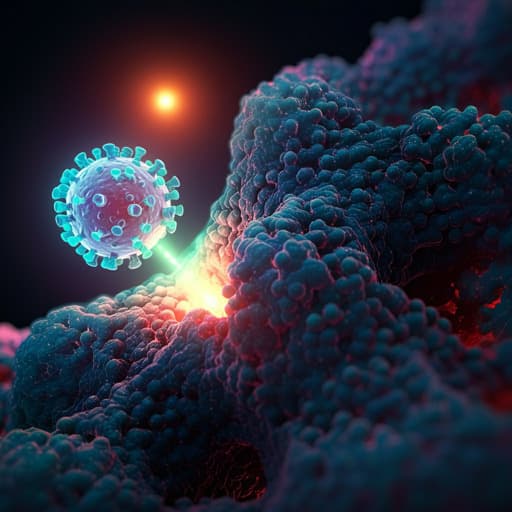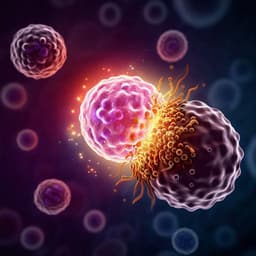
Medicine and Health
Harnessing Biomaterials for Safeguarding Chimeric Antigen Receptor T Cell Therapy: An Artful Expedition in Mitigating Adverse Effects
Z. Chen, Y. Hu, et al.
Discover how researchers Zhaozhao Chen, Yu Hu, and Heng Mei are tackling the challenges of CAR-T cell therapy, such as cytokine release syndrome and neurotoxicity. This innovative review unveils the potential of biomaterials to enhance safety and effectiveness, paving the way for a new era in cancer treatment.
~3 min • Beginner • English
Introduction
CAR-T therapy has transformed cancer care, delivering durable responses in refractory/relapsed CD19+ leukemias and lymphomas and BCMA+ multiple myeloma. Despite this success, clinical translation is challenged by significant toxicities, most notably cytokine release syndrome (CRS), immune effector cell–associated neurotoxicity syndrome (ICANS), and on-target off-tumor toxicities (OTOT), alongside sHLH/MAS, infections, coagulopathy, cytopenias, and viral reactivation. Multiple strategies aim to mitigate these adverse effects, yet optimizing the balance between maximal antitumor efficacy and minimal toxicity remains difficult.
Biomaterials—including inorganic/organic nanoparticles, synthetic polymers, hydrogels, and 3D scaffolds—offer advantages such as targeting, controlled/sustained release, enhanced bioavailability, large drug loading, tunable responsiveness, multifunctionality, ease of customization, and low toxicity. This review explores biomaterial-based strategies to reduce CAR-T-related toxicities, analyzing mechanisms underlying CRS, ICANS, and OTOT and surveying innovative materials-enabled interventions to enhance safety. Traditional paradigms often fail to resolve the efficacy–toxicity trade-off; therefore, principles of biomaterials are leveraged to devise approaches that refine CAR-T strategies and potentially impact broader cellular immunotherapy. The review aims to illuminate biomaterial interventions as a path to safer, more effective CAR-T therapy and outlines their prospective clinical implications.
Literature Review
The review synthesizes mechanistic and preclinical literature on CAR-T toxicities and biomaterial strategies:
- CRS: Triggered by CAR-T activation and tumor engagement leading to high levels of IL-6, IL-1β, TNF-α, IL-2, IFN-γ. Multiple immune and non-immune cells amplify cytokine cascades. Clinical spectrum ranges from fever and hypotension to respiratory distress and multi-organ dysfunction, graded 1–4. Evidence indicates CD4+ CAR-T cells can drive CRS; macrophages/monocytes are key producers of IL-6/IL-1 and NO; CAR-T–mediated tumor pyroptosis via GSDME releases DAMPs (ATP, HMGB1) that activate macrophages; catecholamine self-amplification loops in macrophages exacerbate cytokine release.
- ICANS: Presents from mild encephalopathy to severe neurologic deficits, graded by ASTCT criteria (ICE score, consciousness, seizures, motor findings, ICP/edema). Mechanisms include cytokine surge, BBB disruption, CNS immune infiltration, and glial injury. Single-cell data show CD19 expression on brain mural cells (pericytes, VSMCs), suggesting possible on-target effects that, coupled with BBB breach during CRS, escalate neurotoxicity.
- OTOT: CAR-T recognition of TAAs on normal tissues causes unintended cytotoxicity (e.g., B cell aplasia with CD19 CAR-T). In solid tumors, low-level antigen expression in normal organs can be fatal (e.g., HER2 CAR-T–related pulmonary toxicity). The review discusses synthetic biology approaches (logic gating, suicide switches) and their limitations.
- Biomaterial strategies reviewed include cytokine-sequestering hydrogels (IL-6–adsorbing IL6S), in situ surface PEGylation of CAR-Ts to modulate cell–cell interactions, and remotely actuated CAR control via photothermal switches (Au nanorods + HSPB1), upconversion nanoparticle-enabled light-switchable CARs (LiCAR-T), and prospects for focused ultrasound and other physical triggers. The review also evaluates translational considerations (biocompatibility, degradability, immunogenicity, dosing, administration, and deep-tissue activation limits).
Methodology
Key Findings
- Clinical management context: Corticosteroids and tocilizumab mitigate CRS but can suppress CAR-T expansion/function; tocilizumab has limited efficacy in ICANS and potential adverse reactions. Hence, biomaterials may attenuate toxicity while preserving antitumor activity.
- IL-6–adsorbing hydrogel (IL6S): A thermoresponsive poly(N-isopropylacrylamide-co-methacrylic acid) hydrogel covalently linked to anti–IL-6 antibodies, administered subcutaneously before infusion, captured elevated IL-6 in real time in CRS mouse models (SCID-beige and HuSGM3). Outcomes: significantly reduced serum IL-6 and other cytokines (CCL2, TNF-α, GM-CSF, G-CSF, IL-3, IL-10), reduced mortality, and no adverse hemodynamic effects or fever/weight loss; no neurotoxicity signs. Biocompatible and did not compromise tumor clearance in a Raji xenograft. Hydrogel required ice-induced gel–sol transition for removal; in vivo degradability/clearance not characterized.
- In situ PEGylation of CAR-T cells: Metabolic azide labeling of CAR-Ts followed by in vivo click conjugation with DBCO-PEG600k created a steric shield that reduced CAR-T–monocyte interactions, decreasing monocyte IL-6 and CAR-T TNF-α release. In HuSGM3 CRS/ICANS models, intravenous DBCO-PEG600k (>10 mg/kg) alleviated CRS symptoms, reversed weight loss, tempered cytokine release, and reduced neurotoxicity more effectively than tocilizumab. PEGylation diluted over time with CAR-T proliferation: by day 10, reduced cytotoxicity and cytokines; by day 15, restored tumor killing with TNF-α release but without corresponding IL-6/IL-1 CRS surge, indicating staged recovery favoring antitumor effects over inflammatory activation.
- Remote control of CAR activity to avoid OTOT: Photothermal switch integrating HSPB1 into CAR enabled heat-triggered CAR transcription. With intravenously delivered Au nanorods and CAR-Ts, NIR irradiation activated CARs only in heated, CD19+ tumor regions, limiting off-tumor activation. Upconversion nanoplate-enabled LiCAR-Ts required both blue-light (from 980 nm NIR excitation) and antigen signals to activate, yielding antigen- and spatiotemporally dependent cytotoxicity; in mouse models, reduced B cell aplasia and systemic cytokines. Focused ultrasound offers deeper, noninvasive energy delivery for spatial CAR control, with reports of FUS-gated CAR activity, though dedicated stimulus-responsive materials remain to be developed.
- Translational considerations: Potential PEG immunogenicity (pre-existing anti-PEG IgM/IgG in a significant fraction of healthy individuals) may affect pharmacokinetics and in situ PEGylation efficacy. NIR penetration limits deep-tissue applicability; FUS and other modalities (magnetic, X-ray, electric fields) are proposed to overcome depth constraints. IL6S hydrogel degradability and byproduct clearance require further study; dosing, timing, and administration need optimization in large animals/non-human primates.
- Broader scope: As CAR-T expands to autoimmune diseases (e.g., SLE, RA, T1DM, pemphigus, MuSK MG, colitis, MS), CRS and related toxicities have been observed; biomaterial strategies may similarly enhance safety in these indications.
Discussion
The review demonstrates that biomaterials can modulate the CAR-T therapeutic window by attenuating cytokine-driven toxicities and enabling spatial, temporal, and antigen-dependent activation, thereby addressing CRS, ICANS, and OTOT. Cytokine-sequestering hydrogels provide localized, sustained neutralization of key mediators like IL-6 without globally suppressing CAR-T function. Surface engineering via in situ PEGylation transiently reduces pathologic cell–cell contacts (especially with monocytes/macrophages) to prevent early inflammatory cascades, while allowing later restoration of tumor-targeting activity. Remotely actuated systems (photothermal, upconversion light, and potentially focused ultrasound) confine CAR activation to disease sites, minimizing off-tumor effects.
These strategies collectively support the central hypothesis that biomaterials can serve as precise controllers of CAR-T activity and the inflammatory microenvironment, improving safety without sacrificing efficacy. However, translational success depends on addressing material-specific issues (degradability, immunogenicity, pharmacokinetics), tailoring dosing and routes, and validating performance in larger animal models. The concepts are also relevant to emerging non-oncologic CAR-T applications where immune toxicities similarly pose barriers.
Conclusion
Biomaterials offer versatile, customizable platforms to mitigate key adverse effects of CAR-T therapy. The review highlights three promising directions: (1) cytokine-capturing systems (e.g., IL-6–adsorbing hydrogels) to blunt CRS/ICANS; (2) transient surface shielding (in situ PEGylation) to reduce early monocyte/macrophage activation while preserving later antitumor function; and (3) remotely controlled CAR activation (photothermal, upconversion light, and prospective focused ultrasound) to minimize OTOT through spatially restricted activity. Preclinical studies demonstrate reduced cytokines, lower mortality and neurotoxicity, and maintained or restored antitumor efficacy. Future work should prioritize comprehensive safety evaluations in large animals/non-human primates, optimize administration parameters, and address immunogenicity and deep-tissue activation constraints. As CAR-T expands into autoimmune indications, these biomaterial approaches may similarly enhance safety and therapeutic precision.
Limitations
- The article is a narrative review; no formal systematic methodology is provided. Preclinical evidence predominates, with limited clinical validation of biomaterial strategies.
- IL-6–adsorbing hydrogel (IL6S): in vivo degradability, byproduct clearance, and long-term safety are not fully characterized; data are from small animal models.
- In situ PEGylation: potential impact of pre-existing anti-PEG antibodies on pharmacokinetics and efficacy; optimal dosing/timing and effects in larger species are unknown.
- Remote activation strategies: NIR penetration limits deep-tissue applications; translation to humans requires alternative energy modalities (e.g., focused ultrasound) and development of compatible stimulus-responsive materials.
- Generalizability: Optimal dosing, delivery routes, and schedules for these biomaterials remain to be defined; immunogenicity and off-target effects require thorough evaluation in large animal and non-human primate studies.
Related Publications
Explore these studies to deepen your understanding of the subject.







